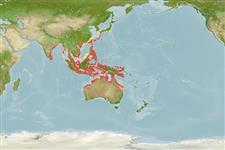Environment: milieu / climate zone / profondeur / distribution range
Écologie
marin; saumâtre récifal; profondeur 1 - ? m (Ref. 48637), usually 1 - 20 m (Ref. 27115). Tropical; 23°C - 28°C (Ref. 27115); 35°N - 25°S, 77°E - 154°E
Indo-West Pacific: southern India, Sri Lanka, Andaman Islands, Thailand, southern and eastern coasts of China, Taiwan, Ryukyu, Philippines, Malaysia, Singapore, Indonesia and Northern Territory in Australia.
Taille / Poids / Âge
Maturité: Lm ? range ? - ? cm
Max length : 30.0 cm TL mâle / non sexé; (Ref. 9710); common length : 20.0 cm TL mâle / non sexé; (Ref. 9813)
Épines dorsales (Total) : 13; Rayons mous dorsaux (Total) : 10; Épines anales: 7; Rayons mous anaux: 9; Vertèbres: 13. A brown band running diagonally from nape to chin; another from 4th-5th dorsal spine base to pectoral fin base; ocular and shoulder bands spotted with blue; a zone of silvery yellow posterior and adjacent to the shoulder band. Preopercular angle 100°-111°; cheek scalation variable from few to almost fully scaled; midline of thorax fully scaled, sometimes with a row missing from pelvic ridges. A prominent rim or short tube encircle the anterior nostril, with a little peak on it posteriorly. Spines stout, fairly pungent and venomous.
Body shape (shape guide): short and / or deep; Cross section: compressed.
Inhabits shallow coastal waters, around hard coral reefs and areas of sand with patches of rock and soft coral. Tolerant of murky waters. Larger juveniles and adults occur in pairs in coastal reef flats, slopes and estuaries . Small juveniles are found in mangroves and enter freshwater, moving to reefs usually in small groups among corals (Ref. 48637). Feed on benthic seaweeds (Ref. 9813).
Life cycle and mating behavior
Maturité | Reproduction | Frai | Œufs | Fécondité | Larves
Woodland, D.J., 1990. Revision of the fish family Siganidae with descriptions of two new species and comments on distribution and biology. Indo-Pac. Fish. (19):136 p. (Ref. 1419)
Statut dans la liste rouge de l'IUCN (Ref. 130435: Version 2025-1)
Utilisations par l'homme
Pêcheries: intérêt commercial mineur; Aquarium: Commercial
Outils
Articles particuliers
Télécharger en XML
Sources Internet
Estimates based on models
Preferred temperature (Réf.
123201): 25.4 - 29.1, mean 28.3 °C (based on 1192 cells).
Phylogenetic diversity index (Réf.
82804): PD
50 = 0.5000 [Uniqueness, from 0.5 = low to 2.0 = high].
Bayesian length-weight: a=0.01905 (0.01036 - 0.03504), b=3.13 (2.97 - 3.29), in cm total length, based on LWR estimates for this species & Genus-body shape (Ref.
93245).
Niveau trophique (Réf.
69278): 2.7 ±0.31 se; based on food items.
Résilience (Réf.
120179): Haut, temps minimum de doublement de population inférieur à 15 mois (Preliminary K or Fecundity.).
Fishing Vulnerability (Ref.
59153): Low vulnerability (20 of 100).
🛈
Nutrients (Ref.
124155): Calcium = 38.5 [18.8, 90.0] mg/100g; Iron = 0.671 [0.313, 1.534] mg/100g; Protein = 19 [18, 20] %; Omega3 = 0.121 [0.063, 0.240] g/100g; Selenium = 20.3 [7.8, 50.6] μg/100g; VitaminA = 33 [9, 121] μg/100g; Zinc = 1.42 [0.56, 3.07] mg/100g (wet weight);
